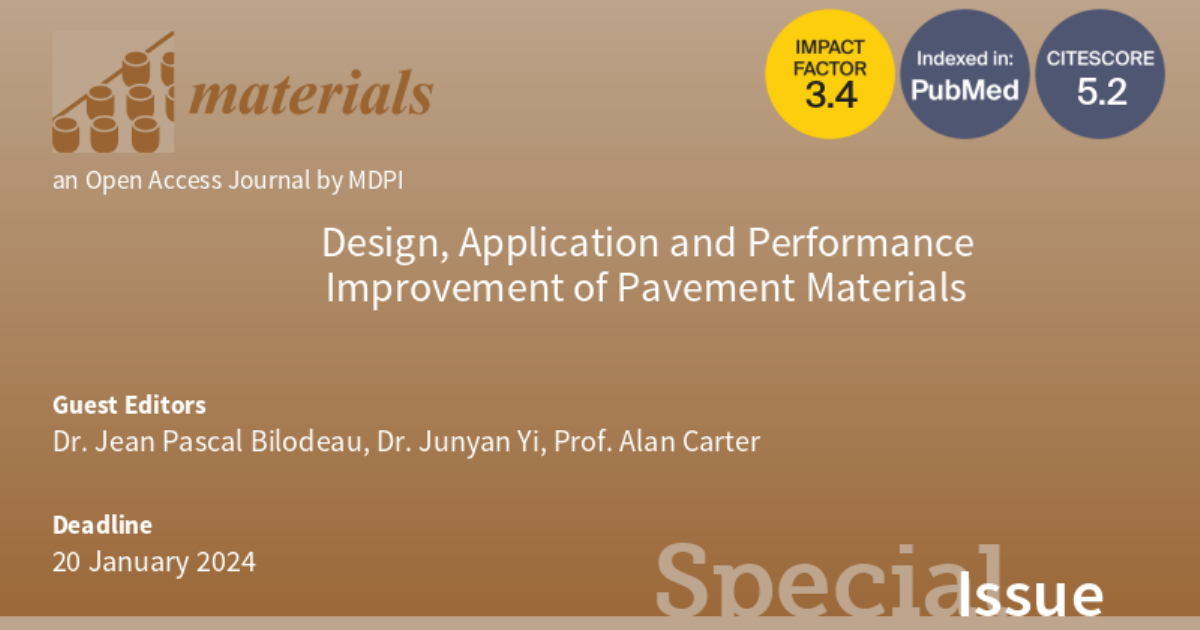Design, Application and Performance Improvement of Pavement Materials
A special issue of Materials (ISSN 1996-1944). This special issue belongs to the section "Construction and Building Materials".
Deadline for manuscript submissions: closed (20 July 2024) | Viewed by 11734

Special Issue Editors
Interests: road geotechnics; unbound granular materials; pavement maintenance and rehabilitation; pavement analysis and design
Interests: multi-scale modeling and rheology of asphalt binder and mixes; transportation sustainability; pavement design, maintenance and rehabilitation
Interests: reclaimed asphalt; waste materials; cold recycling; bitumen modification
Special Issues, Collections and Topics in MDPI journals
Special Issue Information
Dear Colleagues,
This Special Issue of Materials (MDPI) on the design, application and performance improvement of pavement materials aims at providing researchers and scientists with a unique and rewarding opportunity to introduce new and emerging ideas associated with this topic. With the fast-paced evolution of technologies and in the context of ever-growing complexity of technical challenges in pavement engineering, it is crucial to gather state-of-the-art knowledge. Researchers and scientists of the pavement engineering and materials fields are therefore invited to submit original contributions related, but not limited, to areas such as sustainability, recycling, emerging or smart materials, mix design and durability, and methods for design and construction.
Dr. Jean Pascal Bilodeau
Dr. Junyan Yi
Prof. Alan Carter
Guest Editors
Manuscript Submission Information
Manuscripts should be submitted online at www.mdpi.com by registering and logging in to this website. Once you are registered, click here to go to the submission form. Manuscripts can be submitted until the deadline. All submissions that pass pre-check are peer-reviewed. Accepted papers will be published continuously in the journal (as soon as accepted) and will be listed together on the special issue website. Research articles, review articles as well as short communications are invited. For planned papers, a title and short abstract (about 100 words) can be sent to the Editorial Office for announcement on this website.
Submitted manuscripts should not have been published previously, nor be under consideration for publication elsewhere (except conference proceedings papers). All manuscripts are thoroughly refereed through a single-blind peer-review process. A guide for authors and other relevant information for submission of manuscripts is available on the Instructions for Authors page. Materials is an international peer-reviewed open access semimonthly journal published by MDPI.
Please visit the Instructions for Authors page before submitting a manuscript. The Article Processing Charge (APC) for publication in this open access journal is 2600 CHF (Swiss Francs). Submitted papers should be well formatted and use good English. Authors may use MDPI's English editing service prior to publication or during author revisions.
Keywords
- materials
- asphalt concrete
- unbound materials and subgrades
- aggregates
- pavement design
- pavement performance
- technologies
- construction
- durability
- sustainability
Benefits of Publishing in a Special Issue
- Ease of navigation: Grouping papers by topic helps scholars navigate broad scope journals more efficiently.
- Greater discoverability: Special Issues support the reach and impact of scientific research. Articles in Special Issues are more discoverable and cited more frequently.
- Expansion of research network: Special Issues facilitate connections among authors, fostering scientific collaborations.
- External promotion: Articles in Special Issues are often promoted through the journal's social media, increasing their visibility.
- e-Book format: Special Issues with more than 10 articles can be published as dedicated e-books, ensuring wide and rapid dissemination.
Further information on MDPI's Special Issue polices can be found here.








